________________
32
A CULTRAL STUDY OF THE NISITHE CURNI
state-dissension (rajjaviggha).1 Somadeva points out towards the importance of the royal council by saying, "every enterprise of the king should be preceded by deliberation with councillors"2 and that “with the help of the council of ministers the king can achieve all the wishful objects”.8 It can be, therefore, surmised that though endowed with sovereign powers, the kings of the age were duty-bound to consult the royal council for the proper administration of the State. An account of the duties and the stai us of these officials are given in the succeeding paragraphs on the basis of the matter available in the NC.
Crown-prince (yuvaraya )—Next to the king was the crownprince, who, as noted above, was the heir to the throne.5 References reveal that the crown-prince held a very responsible position and represented the king during his absence or illness. He was called adhirāyā or subordinate to the king as against the adirāyā? or the supreme king, and may be identified with the pratinidhis af the Sukranili, who was one amongst the 10 important officials of the State. The iśvara
1. u want HA TITH MARIS THAT THNC. 2, p. 233. 2. Haga: Fajare: faldata14--Vitivā., p. 114. 3. Ibid., p. 130. 4. The Jaina texts describe five kinds of royal council, viz. tūranti,
chattainti, buddha, maiti and rāhassiya. The püranti (pūrayanti) council consisted of the Mahājanas of the State, while the members of the chattanti or chatravcati were given the privilege of holding the royal parasol by the king. The members of the buddhi council were well-versed in the local customs (svasamnı yakus ala), while the miamsi council was the council of the ministers well-read in the political science. The rāhassiya or rākasvihi council consisted of the secret emissaries who were adept in appeasing the angry queens and informed the king about the harem affairs.--See Brh. Vr. 1, p. 113. For details of these councils see also--LAI., p. 59; also Sikdar, op. cit.,
pp. 97-98. 5. NC. 2, p. 449. 6. NC. 2, p. 462. 7. NC. 2, p. 449. For adirajā as a title of the sup eme king see also
Cunningham, The Stura of Bharaliut, p. 143. 8. Sukri niti, II. 70-72.
Jain Education International
For Private & Personal Use Only
www.jainelibrary.org




